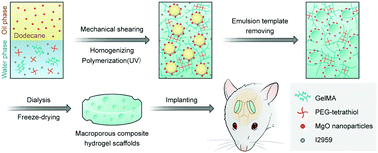Engineered macroporous hydrogel scaffolds via pickering emulsions stabilized by MgO nanoparticles promote bone regeneration†
Abstract
Hydrogels are appealing biomaterials for regenerative medicine since biomimetic modifications of their polymeric network can provide unique physical properties and emulate the native extracellular matrix (ECM). Meanwhile, therapeutic metal ions, such as magnesium ions (Mg2+), not only regulate cellular behaviours but also stimulate local bone formation and healing. However, the absence of a meaningful macroporous structure and the uncompromising mechanical strength are still challenges. Herein, we designed a macroporous composite hydrogel based on mild and fast thiol–ene click reactions. The Pickering emulsion method was adopted to form a macroporous structure and introduce MgO nanoparticles (NPs). The results show that the composite hydrogel possesses good mechanical strength and an evenly distributed macroporous structure. MgO NPs stabilized at the oil/water interface not only function as effective emulsion stabilizers, but also enhance the mechanical properties of hydrogels and mediate the sustained release of Mg2+. In vitro cell experiments demonstrated that the composite hydrogel displays good biocompatibility. More importantly, the release of Mg2+ ions from hydrogels can effectively promote the osteogenic differentiation of BMSCs. Furthermore, an in vivo study showed that macroporous hydrogels can provide a good extracellular matrix microenvironment for in situ osteogenesis and accelerate bone tissue regeneration.

- This article is part of the themed collection: Editor’s Choice: Tissue Engineering


 Please wait while we load your content...
Please wait while we load your content...